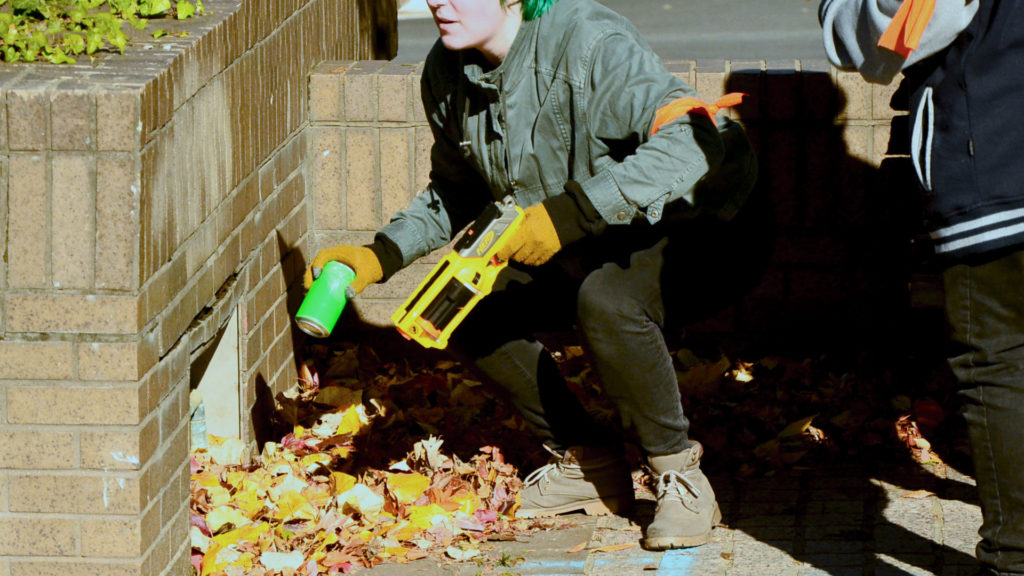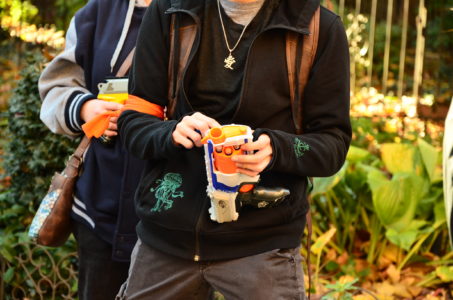-
ARCHDAMON
the work of Damon Stallman
Urban Gaming
Urban Gaming
Urban Games, Live-action Roleplay, Interactive Theater
The MICA Urban Gaming Club ran a week-long campus-wide game every semester on the MICA campus, located in the neighborhood of Bolton Hill in Baltimore, MD. Each game involved a fully written and real-time interactive theatrical narrative and daily missions and objectives for players. Each game was designed by a group of 5-6 designers throughout the semester.
In the Fall Semester, the Urban Gaming Club hosted the campus game Humans VS Zombies, and each year developed a new theme with organized missions and objectives. In the Spring Semester, we developed an entirely original game for 3 teams with the inclusion of extra objectives and a more active storyline.
Project Role
Co-President, Game Designer, Narrative Designer, Community Organizer, Performer, Moderator, Writer
Collaborators
Allison Whitney, Yurie Murayama
Nastia Garachtchenko, Léa Leroy
Chuck Natividad, Rosie Cerrone
Jenna Yow, Charlie Reynolds
Corran Nolan, Drew Morse
Gameplay involved a game of Nerf Blaster tag. In Humans VS Zombies games, we would designate one Original Zombie, and everyone else would start as a Human. When a Zombie tags a human, that human becomes a Zombie. If a Zombie is hit with a nerf blaster dart, they cannot tag a Human unless they respawn at a specific site or 10 minutes goes by. Humans can receive consumable items to keep them from turning into a Zombie, and Zombies can earn items to turn them back into a Human. The objective for Humans is to stay alive until the end of the game, and the objective for Zombies is to turn all the Humans into Zombies.
During the Spring games, players were put into 3 teams. Players completed daily and nightly mission objectives to earn XP that they could spend to earn consumable items, permanent buffs, and the opportunity to use different playstyles. They were able to use foam boffer weapons, shields, Nerf blasters, and clean balled up socks to tag players on opposing teams. Players could also earn XP through tagging other players, roleplaying with an NPC, and completing Character Quests given by NPCs.
Responsibilities
Game Design: For each game, we began planning the theme during the break in between semesters. We collaborated and decided based on past games and player feedback, and carefully decided on missions and rules for each day of game week.
Asset Creation: I designed cards for items and character designs for multiple games.
Community Organizing & Management: Planning began weeks before the game, where I was responsible for filling out proper paperwork, planning and attending meetings, filling out budget sheets, creating documents and spreadsheets to plan missions, and reserving spaces with respective coordinators and officials. During game week, I wrote and responded to emails from coordinators and players, kept spreadsheets and documents to keep track of players, and remained on call for player needs.
Performing: During each game, I performed as an NPC character and interacted with players as an actor. I was present in-character during each night mission, and multiple times throughout the day.
Moderating: Throughout the course of the game, I watched over players to ensure everyone was following community rules. During rule infractions, I maintained a professional, empathetic, but firm position, and handled each matter with discretion, prioritizing player safety. I was also present to aid players in understanding rules and managing conflict.
Writer: I wrote posts and emails for missions to inform and continue the narrative for each game.
Process
I was a Co-President of the MICA Urban Gaming Club for 3 years, and I planned 5 games as a Designer and Moderator:
Spring 2018: Dead in the Desert
Fall 2018: Humans VS Zombies – Dead Man on Deck
Spring 2019: Jones Plaza
Fall 2019: Humans VS Zombies – UnDead or Alive
Spring 2020: Beast Lake
I worked on a team of 5-6 designers for each game, and planning for each game typically took around 2-3 months. In between semesters, we would interview and recruit new moderators and pitch ideas for the next game. During the semester, we met once a week for a few hours to decide on our theme, create missions, determine meetings, discuss budget, and assign assets. In between meetings, we were individually responsible for designing our characters, brainstorming quests and missions related to our game, attending meetings with our advisor and with Residential Coordinators, and produce art assets for the physical production of the games. Each player was required to attend a Safety Meeting presentation before playing. During the course of the game, moderators were on duty from 7am-12am to interact with players.


















